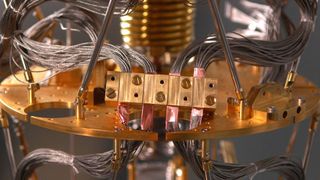Never mind DDR5, quantum RAM could be a thing thanks to time crystals
Time crystals could have practical applications for quantum computers

Those in the field of quantum computing have long been working on pushing forward developing quantum processors, of course, but the prospect of quantum RAM just popped onto the scene, thanks to new research into so-called ‘time crystals’.
As Tom’s Hardware, which spotted this, points out, the idea of time crystals is not a new one, and they were first theorized a decade ago by Frank Wilczek, a theoretical physicist who scooped a Nobel.
Then in 2016, two groups of scientists laid claim to creating the first time crystals, and now, in a new paper published via Nature, researchers from the Aalto University in Finland have successfully experimented with a pair of coupled time crystals, and this could potentially point the way to the creation of quantum RAM as mentioned.
What exactly is a time crystal? It’s a quantum system with particles in a periodic pattern of motion which repeats and is sustained in perpetuity, without burning or creating energy.
In other words, this is a system that achieves a stable state of motion without energy – yet still obeys the laws of thermodynamics. There’s no work carried out in the system, or energy that can be tapped from it.
The researchers created their system of two coupled time crystals in helium-3 in a superfluid state (achieved by cooling to just a tiny amount above absolute zero), using a laser to create the time crystals (pumping energy into them).
Analysis: Major RAMifications down the line?
In this experiment, the time crystal’s movement continued not indefinitely, but for almost 17 minutes, although that really is an absolute age in quantum computing (where coherence times are measured in milliseconds, and not even seconds – let alone minutes).
Are you a pro? Subscribe to our newsletter
Sign up to the TechRadar Pro newsletter to get all the top news, opinion, features and guidance your business needs to succeed!
And it’s long enough to prompt the speculation that time crystals could eventually be the key to unlocking the quantum computing equivalent of RAM, acting as a system with the potential for lasting storage that the quantum processor can access. What’s more, the researchers have also theorized that this system of coupled time crystals could be made to work at room temperature (rather than having to be cooled to very nearly absolute zero, as is the case with this experiment, which is not very practical of course).
In short, there seem decent prospects that this idea of quantum RAM made with time crystals could eventually see the light of day; although in reality, there’s still a whole lot of road to travel down (and that’s true enough about the broader world of quantum computers, of course).
Darren is a freelancer writing news and features for TechRadar (and occasionally T3) across a broad range of computing topics including CPUs, GPUs, various other hardware, VPNs, antivirus and more. He has written about tech for the best part of three decades, and writes books in his spare time (his debut novel - 'I Know What You Did Last Supper' - was published by Hachette UK in 2013).
Most Popular

